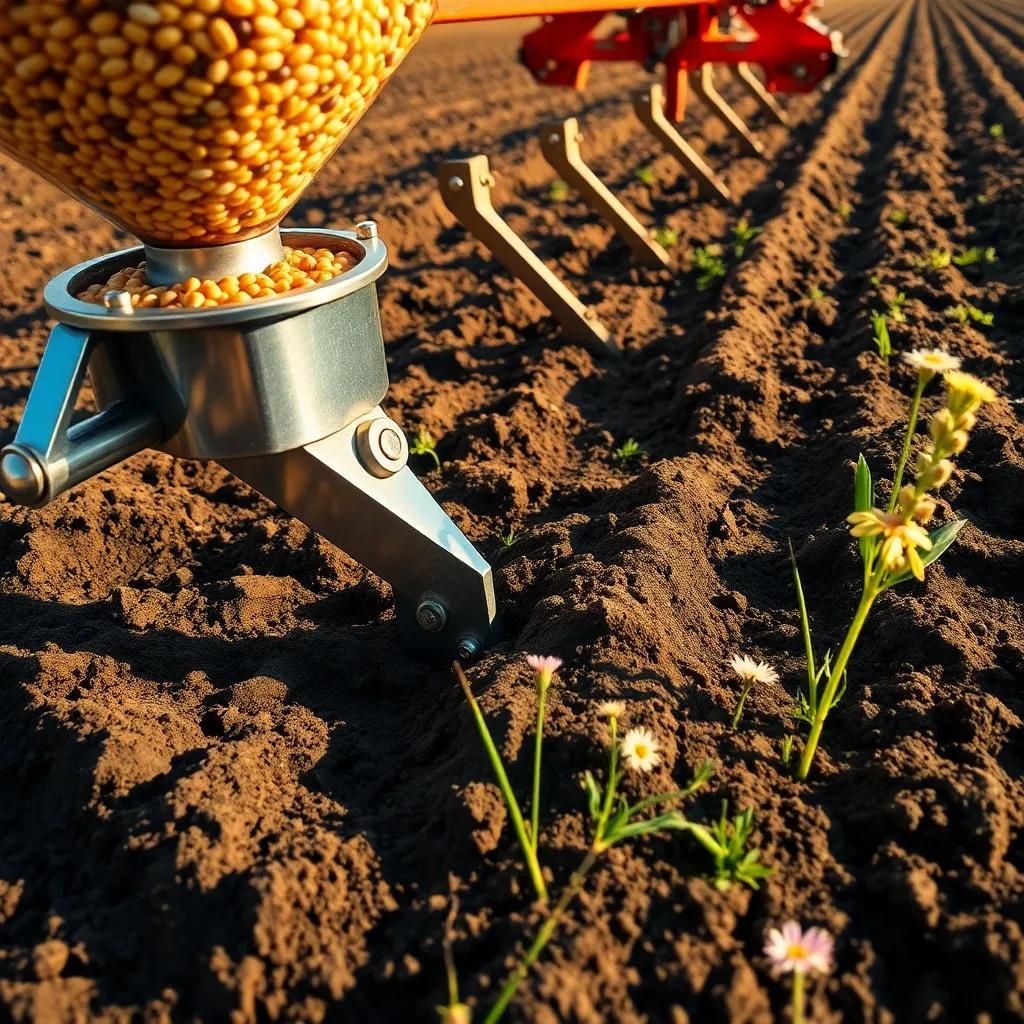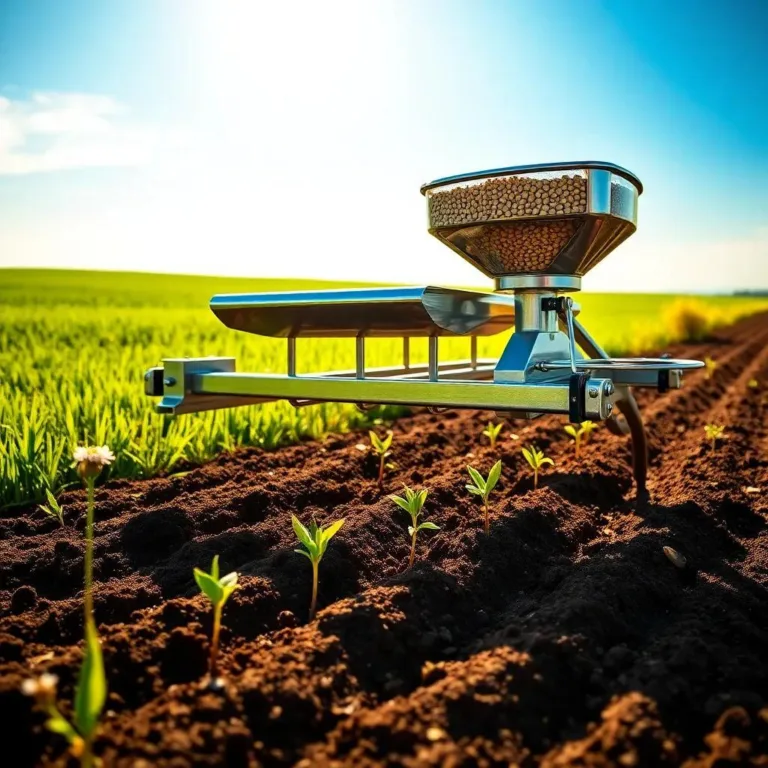Are you ready to take your gardening game to the next level? With seed drills, planting seeds becomes a breeze, and you might even have some fun while doing it! Join me as we explore the awesome components, mechanisms, and benefits of these handy tools that can help your garden flourish like never before!
Components of a Seed Drill: An Overview
Let’s take a closer look at the components of a seed drill! This amazing machine is designed to make planting seeds as easy as pie! With just a few key parts, the seed drill can plant seeds precisely where they need to go. Here are the main components that make it all happen:
- Seed Hopper: This is the big container that holds all the seeds! You fill it up with the seeds you want to plant, and it distributes them throughout the planting process.
- Seed Metering Device: Imagine a friendly little gatekeeper that controls how many seeds come out of the hopper! This device ensures the seeds flow at just the right rate, so you don’t end up with a yard full of seeds bunched together!
- Furrow Openers: Think of these as tiny plows that slice through the soil! The furrow openers create neat little trenches where the seeds will be placed. You can adjust them to make deeper or shallower furrows depending on your crop requirements.
- Seed Tubes: Once the seeds are ready to go, they travel down these tubes into the furrows! It’s like a little slide for seeds, making sure they land safely in their new home.
- Press Wheels: After the seeds are in the ground, the press wheels come in! They gently press down the soil around the seeds, ensuring they get cozy and snug in their new beds. This helps with seed-to-soil contact, which is super important for germination!
Each of these components plays a vital role in the process. They work together to plant seeds accurately and efficiently, giving your plants the best possible start. Using a seed drill not only saves time but also helps maximize crop yields, making gardening or farming more enjoyable!
Working Mechanism of Seed Drills Explained
Now that we’ve covered the components, let’s explore the working mechanism of seed drills! It’s like a well-coordinated dance, as each part performs its job beautifully to get those seeds safely in the ground. Here’s how the magic happens:
- Filling the Seed Hopper: First, I load up the seed hopper with my chosen seeds. This is where the journey begins!
- Seed Distribution: Next, the seed metering device kicks in, controlling the flow of seeds. It’s like a magic trick! The device ensures that just the right amount of seeds comes out, so I know they won’t be crowded in their furrows.
- Creating Furrows: As I push or pull the seed drill, the furrow openers slice through the soil, creating those perfect little trenches. I can adjust the depth depending on the kind of seeds I’m planting!
- Placing the Seeds: The seeds are then funneled through the seed tubes right into the furrows. It’s like sending them off on an adventure to their new home!
- Covering the Seeds: After the seeds are placed, the press wheels follow closely behind, gently covering the seeds with soil. This helps them feel secure and promotes effective contact with the soil. It’s like tucking them in for a good night’s sleep!
- Repeating the Cycle: The process continues as I move forward, planting rows of seeds evenly spaced out. This promotes proper germination and growth, which makes my garden look fantastic!
By understanding how seed drills work, we can appreciate their efficiency and effectiveness in planting seeds. It’s truly an ingenious invention that makes gardening easier while helping us grow healthy crops! So, are you ready to make the most of your planting endeavors? Let’s get our hands dirty and have some fun!

Benefits of Utilizing Seed Drills in Agriculture
Using a seed drill can really transform the way I approach gardening or farming! There are so many benefits to this nifty tool that make planting seeds easier and more efficient. Let’s explore some of the fantastic reasons to use a seed drill:
- Precision Planting: With a seed drill, I can plant seeds at the exact depth and spacing they need. This is super important for helping my plants grow evenly and strong! It reduces the hassle of having to thin out plants later.
- Time-Saver: Have you ever spent hours planting seeds by hand? I have! Seed drills drastically cut down on time and make it possible to cover larger areas in a short amount of time. I can focus on other tasks, like enjoying a nice cup of coffee!
- Reduced Seed Waste: When I use a seed drill, I know my seeds are going exactly where I want them. This means less seed wastage, which is great for my wallet too! Accurate planting means I’m not scattering seeds randomly and losing them in the weeds.
- Better Crop Health: With the perfect seed-to-soil contact, my seeds have a better chance to germinate and grow! This leads to healthier plants that develop strong roots and lush foliage.
- Versatile Options: Seed drills come in different sizes and styles, making it easy for me to find one that fits my gardening needs, whether I have a tiny garden or a big farm!
Using a seed drill really gives me the advantage when planting seeds. It makes my gardening experience smoother and more enjoyable, leading to a bountiful harvest!
Common Types of Seed Drills and Their Uses
When it comes to seed drills, there are quite a few types to choose from, each designed for different planting needs! Knowing which one suits my situation can make all the difference. Here are some of the most common types of seed drills:
- Handheld Seed Drills: These are perfect for small-scale gardening! Lightweight and easy to use, they allow me to plant seeds precisely in small spaces like raised beds or containers.
- Push Seed Drills: A step up from the handheld ones, push seed drills require a little muscle! I just push them along the soil, and they drop seeds into the furrows. They’re great for medium-sized gardens.
- Tractor-Mounted Seed Drills: For larger farming operations, these powerful machines are a game-changer! They attach to the back of a tractor and can cover vast areas quickly, adjusting to various seed types and planting densities.
- Pneumatic Seed Drills: These fancy models use air to transport seeds! They’re excellent for commercial agriculture, helping me plant seeds accurately for crops like corn and soybeans.
- No-Till Seed Drills: Perfect for conservation practices, these drills plant seeds directly into soil without major disturbances. This helps preserve soil structure while minimizing erosion.
Choosing the right seed drill depends on my specific gardening or farming needs. Whether I’m tending to a small backyard or a sprawling field, there’s a seed drill out there that fits the bill!
Factors to Consider When Operating Seed Drills
Using a seed drill is exciting, but there are a few important factors I should keep in mind to get the best results. After all, I want my planting process to go as smoothly as possible! Here are the key things to consider:
- Soil Condition: Before I start planting, I always check the soil! Is it too wet or too dry? Understanding the soil’s texture and moisture level helps me adjust the seed drill for better performance.
- Quality of Seeds: I make sure to use good-quality seeds. They should be disease-free and ready to grow! If the seeds are bad, it could hinder my whole planting effort, and nobody wants that!
- Proper Calibration: Calibration is a fancy word for making sure everything is set up correctly! I take time to adjust the drill for the specific seeds I’m using – depth, spacing, and the rate of seed flow all need to be just right!
- Weather Conditions: I always check the weather before planting! If it’s going to rain heavily, it could affect how well the seeds settle in the soil. Timing can make a big difference!
- Regular Maintenance: Keeping my seed drill in great shape is key. After each use, I clean it, lubricate moving parts, and inspect for any damage. This ensures it works smoothly for many planting seasons ahead.
By keeping these factors in mind when using a seed drill, I can optimize my planting experience and enjoy healthy, vibrant plants! So, let’s get planting!

